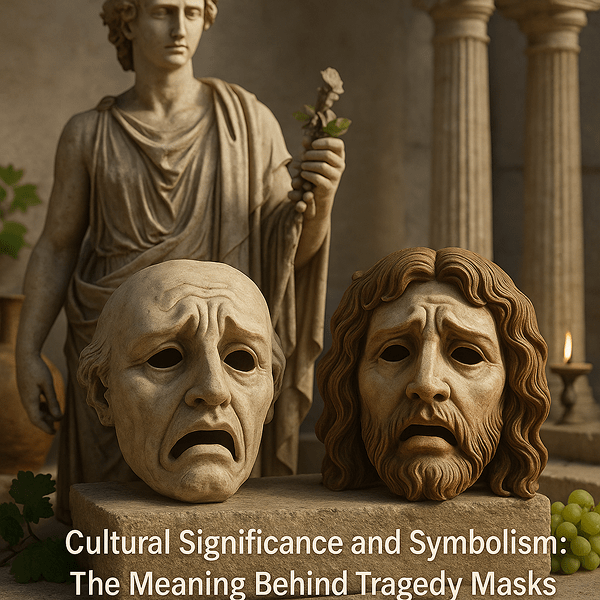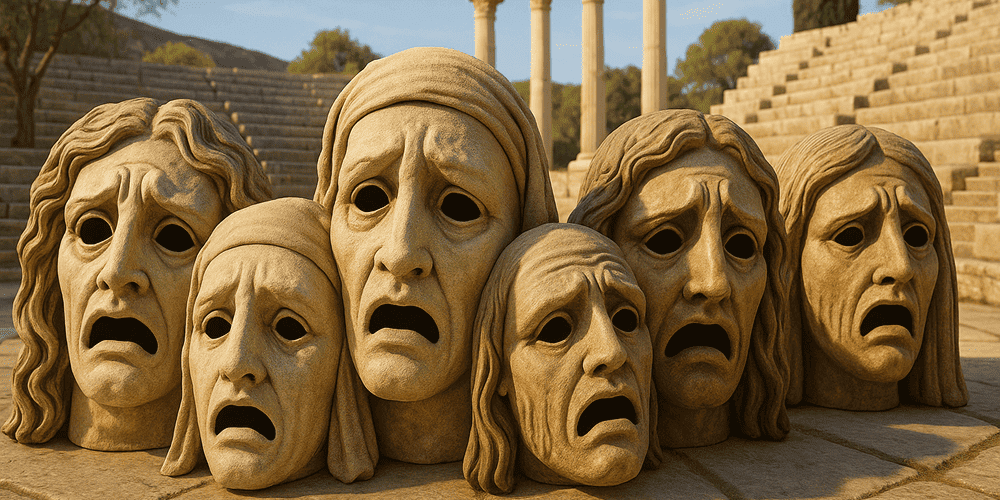Tragedy Masks are one of the most enduring symbols of ancient Greek culture and the dramatic arts. Instantly recognizable for their somber expressions, deep-set eyes, and exaggerated features, these masks were integral to the performance of tragic plays in the open-air theatres of classical Greece. Tragedy Masks are typically characterized by a downturned mouth, furrowed brows, and lifelike yet stylized details that convey suffering, nobility, and the gravity of fate. Originating in the region of Attica, especially in Athens, Tragedy Masks emerged as a defining feature of Greek theatre during the 5th century BCE, a period often called the “Golden Age” of Greek drama.
Historical Origins: The Development of Greek Tragedy Masks
The history of Tragedy Masks is inseparable from the evolution of Greek theatre itself. The word “tragedy” comes from the Greek “tragōidia,” meaning “goat song,” which alludes to the ritual origins of the genre in Dionysian festivals. Early masks were likely simple and utilitarian, evolving over time into highly expressive works of art as theatrical traditions matured. By the classical era, masks had become essential for actors, who often played multiple roles and needed to project emotions to large audiences. Archaeological finds, such as terracotta mask miniatures and ancient vase paintings, provide evidence of the use and development of Tragedy Masks. These artifacts reveal a gradual shift from basic forms to intricately crafted masks capable of expressing a wide range of human emotions, from anguish to catharsis.
Cultural Significance and Symbolism: The Meaning Behind Tragedy Masks
In Greek culture, Tragedy Masks held deep symbolic resonance. They were not only theatrical tools, but also spiritual objects believed to channel the presence of gods, heroes, and mythic figures. The mask’s exaggerated features allowed actors to embody larger-than-life characters and explore universal themes such as fate, justice, and human suffering. Tragedy Masks also played a role in religious rituals dedicated to Dionysus, the god of theatre and wine, reinforcing the sacred dimension of the dramatic arts. Myths and legends often reference the transformative power of masks, and their use in both mourning and celebration. Socially, the use of Tragedy Masks in theatre fostered civic unity and dialogue, creating a shared space for reflection and emotional catharsis. For those interested in the broader context of Greek drama, it is interesting to note that Comedy Masks were used alongside Tragedy Masks to create a full spectrum of theatrical expression.

Materials and Craftsmanship: Creating Authentic Tragedy Masks
Traditional Tragedy Masks were crafted from a variety of lightweight, durable materials, including linen, wood, leather, and, most commonly, clay or papier-mâché. The process began with molding the basic shape over a wooden form, followed by sculpting or layering to build up facial features. Artisans used knives, chisels, and sculpting tools to exaggerate the eyes, mouth, and brows, ensuring each mask conveyed a distinct tragic persona. Once formed, the mask was painted with natural pigments — often in muted or earth tones to suit the somber themes of the play. Some masks were further decorated with hair, fabric, or metallic elements to enhance their realism. Regional variations existed, with Athenian masks tending toward more refined and expressive styles. The color palette and decorative patterns were often chosen to reflect the status and character of the role being portrayed.
Functions and Use: The Role of Tragedy Masks in Performance and Ritual
The primary function of Tragedy Masks was theatrical — they enabled actors to take on multiple roles, project emotions to distant spectators, and maintain anonymity while channeling the essence of their characters. In the context of the Dionysia and other major festivals, Tragedy Masks were used in ceremonial processions, competitions, and public performances attended by thousands. Besides theatre, masks occasionally featured in funerary rites, religious ceremonies, and civic celebrations, reinforcing their connection to both the sacred and the communal. Over time, the use of Tragedy Masks expanded to include educational reenactments, museum displays, and modern revivals of ancient drama. Contemporary theatre directors and mask-makers continue to draw inspiration from these ancient forms, adapting them for new audiences and purposes.
Regional Variations: Local Styles and Cross-Cultural Comparisons
Tragedy Masks varied across different regions of Greece and periods of history. Athenian masks were typically more sophisticated, with subtle gradations of expression, while masks from other city-states might feature bolder, more stylized forms. Unique local features could include the use of specific colors, materials, or decorative motifs. When compared to other mask traditions — such as Roman theatrical masks, Etruscan funerary masks, or Japanese Noh theatre masks — Greek Tragedy Masks stand out for their focus on emotional realism and narrative clarity. The interplay between Tragedy and Comedy Masks also highlights the dynamic range of Greek theatrical culture.
Famous Examples and Collections: Where to See Tragedy Masks
Many of the most significant Tragedy Masks are preserved as archaeological finds, museum pieces, or artistic replicas. The National Archaeological Museum in Athens and the British Museum in London house notable collections of ancient Greek masks, including terracotta miniatures and sculpted reliefs. The Louvre Museum and the Metropolitan Museum of Art also feature important artifacts related to Greek theatre. Private collectors and theatrical archives sometimes display replicas or historically inspired masks. For anyone interested in viewing or acquiring authentic or reproduction Tragedy Masks, online galleries like toddmasks.com offer curated selections and educational content.

Influence on Art and Culture: The Enduring Legacy of Tragedy Masks
The impact of Tragedy Masks on Western art, literature, and performance is immense. Their iconic forms have inspired painters, sculptors, playwrights, and filmmakers for centuries. Tragedy Masks appear in ancient and modern literature, from the plays of Sophocles and Euripides to contemporary poetry and drama. In visual arts, they are used as symbols of sorrow, nobility, and the human condition. The influence of Tragedy Masks extends to modern theatre, opera, and even fashion, where mask motifs evoke themes of drama and transformation. Their role in preserving and transmitting Greek cultural heritage is profound, as is their continued use in educational and artistic settings.
Modern Status and Preservation: Keeping the Tradition Alive
Today, the tradition of making and using Tragedy Masks is sustained by dedicated artisans, theatre companies, and educational institutions. Workshops, masterclasses, and cultural festivals offer opportunities for hands-on learning and creative experimentation. Modern mask-makers explore both traditional and innovative materials, adapting ancient designs for contemporary performance. Museums and universities play a key role in documenting, exhibiting, and teaching about Tragedy Masks, ensuring that their legacy endures for future generations. Collaborative projects and digital resources further support the transmission of this unique art form.
Collecting and Acquisition: The Market for Tragedy Masks
The market for Tragedy Masks includes both genuine archaeological artifacts and high-quality reproductions. Authentic ancient masks are rare and typically held by museums, but skilled artisans create faithful replicas for collectors, educators, and theatre companies. These replicas can be found in specialty shops, museum stores, and online platforms such as toddmasks.com. Prices vary depending on materials, craftsmanship, and provenance. When collecting, buyers should seek documentation of authenticity and consider the ethical implications of acquiring cultural artifacts.
